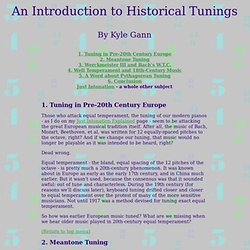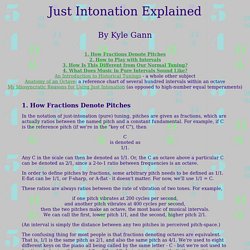

An Introduction to Historical Tunings. Or if G vibrates at 100 cycles per second, then B vibrates at 125, and so on.

(If you'd like this explained in more detail, visit my Just Intonation Explained page.) The size of a pure 5:4 major third is 386.3 cents, a cent being one 1200th of an octave, or one 100th of a half-step. Since an octave is 1200 cents, by definition, it is easy to see that three pure major thirds (3 x 386.3 cents = 1158.9) do not equal an octave. That's the whole problem of keyboard tuning, where you're limited to 12 steps per octave. Where do you put the gaps in your chains of perfect major thirds? A pure perfect fifth is a 3 to 2 frequency ratio; if vibrates at 440 cycles per second, then E vibrates at 660 cycles per second. Let's look at the meantone solution.
A major third and perfect fifth on the same pitch, of course, make up a major triad, the most common chord in European music from 1500 to 1900 - the meantone era. The major thirds that are about 386 cents wide will be sweet, consonant, attractive. Key Color. Relating Tuning and Timbre. This is the full text of the article (more or less) as it first appeared in Experimental Musical Instruments.

It was the catalyst for much of the work that resulted in Tuning Timbre Spectrum Scale, and it contains links to computer programs that will make it easy for you to draw dissonance curves yourself. James Forrest has recently created a Java applet for interactive exploration of dissonance curves. Introduction If you've ever attempted to play music in weird tunings (where "weird" means anything other than 12 tone equal temperament), then you've probably noticed that certain timbres (or tones) sound good in some scales and not in others. 17 and 19 tone equal temperament are easy to play in, for instance, because many of the standard timbres in synthesizers sound fine in these tunings. I remember when I first played in 16 tone. Just Intonation Explained. You can figure out the rest.

There is a rather complicated formula for figuring out how many cents large an interval is: Divide 1200 by the logarithm of 2. If you use base 10 logarithms (any base is permitted), 1200/log 2 = 3986.3137... For any ratio n/p, the number of cents in the interval is log (n/p) x 1200/log 2 If you're using log 10, then cents = log (n/p) x 3986.3137... Using this formula, we can obtain the following interval sizes: 16/15 = 111.73... cents 9/8 = 203.91 cents 8/7 = 231.17... cents 7/6 = 266.87... cents 6/5 = 315.64... cents 11/9 = 347.4... cents 5/4 = 386.31... cents 9/7 = 435.08... cents 1323/1024 = 443.52... cents 21/16 = 470.78... cents 4/3 = 498 cents 7/5 = 582.51... cents 3/2 = 702 cents And so on, and so on. The smaller the numbers in an interval's ratio, the more consonant (sweet-sounding) it is, and the more useful it is for purposes of musical intelligibility. By the way, it's really not so difficult to learn to recognize these intervals by ear.